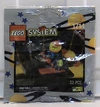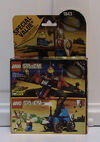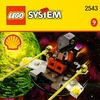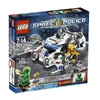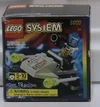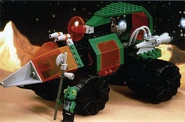Space is a science fiction-based theme introduced in 1978 featuring Astronauts, aliens, robots, and spaceships. It is one of the most expansive themes in LEGO's history, and contains over 362 individual sets.
As one of the core themes along with Town and Castle, Space has been running almost constantly for over 35 years. Since Mars Mission, a new Space subtheme has been constantly available, save for a gap in 2012 and 2014-2023 (except for a couple one-off sets). The Space theme returned in 2024 as being marketed in other existing themes such as City and Dreamzzz. It is one of LEGO's oldest series.
History[]
Classic Space (1978-1987)[]
- See main article: Classic Space
The first LEGO Space sets were a leap forward in classic LEGO design. The theme had more sets than any other space theme. In 1987, many of the sets started to have the Futuron colour theme. 1987 was also the last year Classic Space was produced. Many compared to the LEGO Company's previous releases of spacecraft sets 801 Space Rocket (1964), 358 Rocket Base (1973), and 565 Moon Landing (1975) this new theme of sets boasted new parts and building techniques previously unseen. Although plenty of basic bricks were used, there were now parts with finer detail used in smoother-looking ships and multi-purpose vehicles. The Spacemen came in all colours, with robots and vehicles with a large colour scheme.
Despite curiosities and oddities such as steering wheels used to direct spacecraft, and often no inflight pilot protection other than a spacesuit, simple new constructs sparked builders' imaginations. Starting with spaceships and basic wheeled vehicles, the theme developed, occasionally mirroring science fiction designs. As LEGO Space expanded, the basic pattern of ground-buggies, walking robots, small and large spaceships, and bases emerged. There was even a mobile base, one of the earliest released.
Early Space sets had a simplistically modern, yet colourful, charm unrivaled by any other mass-produced science-fiction toy of the time. Many of the theme's more specialized pieces had yet to be developed, although when Space was first introduced many parts were new, or were older parts made in new colours. Examples of these early simple sets include: 462 Rocket Launcher (1978), 442 Space Shuttle, and 452 Mobile Tracking Station (both 1979).
Perfectly suited for utilitarian LEGO Space, gray (now replaced by stone colours) had finally become a major colour for a LEGO theme, especially as more plate-type parts were made in that colour. Most often, gray Space sets were paired with green windows. The other predominant colours were blue with yellow windows. With the introduction of the 6929 Starfleet Voyager in 1981, classic spaceships began to appear in white, with blue canopies, in a similar style to the upcoming Futuron.
The numbering of Space sets suggests that LEGO had already planned out their sets all the way through Insectoids, as the set number of the ship increased, so did the ship size. Most of the sets did not have a number directly below or above the number of another set from the theme, instead being next to sets from other Space themes. Other than the odd numbering of Unitron, which were in the 1000s (and the Monorail Transport Base is the exception, with a 6000 set number), the pattern was more or less concise.
Introduction of different factions (1987-1991)[]
Taking over from Classic Space and inheriting its white-and-blue colour scheme, Futuron was one of the new factions introduced for Space. Its minifigures came in many colours (red, blue, yellow and black), but all shared the same uniform—a zipper crossing from hip to shoulder, with colour on top and white below—as well as light-blue-tinted helmet visors. They also had the old Classic Space symbol. Instead of a big ship, the theme centered around the 6990 Monorail Transport System, which featured a battery-powered train system and some twenty linear feet of track. Accessory tracks were also released.
The first unified and truly themed Space theme, Blacktron took to the stars in black with yellow trim, and red and yellow transparent pieces. (The odd man out was the 1875 Meteor Monitor, which was white and black with red transparents.) Blacktron minifigures (or "minifigs" for short) wore black jumpsuits akin to today's military pilots, with white trim and opaque black visors. Stylish, sleek and intimidating, Blacktron was a major step up from the rather clunky design values of Classic Space. It featured a large spacecraft, the "Renegade," which set the tone for all future big ships by splitting into a number of smaller modules, including a storage bin for a small wheeled vehicle; these modules could be recombined not just with each other, but with modules from other vehicles in the set as well, specifically the "Invader" and "Battrax." This modular interchangeability has been a staple of LEGO Space ever since. Oddly, they weren't always symmetrical. Their large base, the Message Intercept Base, featured many large transparent yellow parts unique to the set. Many of the trans yellow parts from the theme were not used outside of the theme. The Blacktron's torso also appeared on Rench.
For clarification, Blacktron is often referred to as Blacktron I, as LEGO released Blacktron II in 1991. Though Blacktron officially ended in 1988, the 1875 Meteor Monitor (1990) was released. Considering Blacktron II's slightly altered colour scheme it could be viewed as being from between the "upgrade" era of Blacktron to Blacktron II.

M-Tron astronauts are assisting their fellows from Futuron in a catalog scene from 1990.
In 1989, LEGO made a storyline decision. Blacktron, previously operating in a moral void, were now declared the "bad guys" of LEGO Space; opposing them and defending Futuron from them were the Space Police, a series of brave individuals whose spacecraft were black and blue with red transparent elements. (This would be a continuing theme of space, having "bad guy" space agencies, "good guy" space agencies and "civilian" space agencies between them.) Space Police re-introduced the idea of modular systems, on a smaller but also grander scale. The Space Police theme features three spaceships, two wheeled vehicles and a ground-based space station; all but the smallest buggy comes with a Space Police jail cell (which was often supplied with a Blacktron occupant). These jail cells were identical from set to set and could be traded around between vehicles with no hassle whatsoever. Their minifigures were identical to Futuron astronauts but with different visors.
In an effort to increase interactivity, LEGO introduced magnets in the next Space theme, M-Tron, who took over the "civilian" role of the Futuron space agency. Vehicles in this set, distinctive for their red hulls, gray trim and neon-green canopies, are devoted primarily to mining out precious ores. They often featured crane-like attachments with magnets for picking up small cargo and storage boxes. These boxes, unfortunately, were generally not interchangeable.
M-Tron was also the last space theme to carry the LEGOLAND banner. LEGO System was the name used starting in 1992.
Renewal of the first factions (1991-1997)[]
In 1991, Blacktron received a makeover: black with white trim, M-Tron's neon green canopies, as well as new uniforms with black hexagons in the center with an over-sized lime green 'B' in it. It also replaced the creative but haphazard interchangeability of Blacktron I with refined and mostly-uniform cockpit globes (best seen here), which could be switched unimpeded between those ships. To the dismay of fans, however, only three sets of eleven featured them. Some fans were also disappointed that, aside from a proliferation of small (50-element-or-less) vehicles, Blacktron II seemed to be mostly a rehash Blacktron I on a set-by-set basis.
Space Police was the next theme to receive a makeover, remodeled into its more widely recognized black and grey with green canopies and red trim. The standardized jail cells were retained, though only three vehicles could accept them; the theme also lacked a permanent installation like Space Police I's 6955 Space Lock-Up Isolation Base (1989). It was the first Space set to replace the LEGO standard smiley face minifigure head with a more complex graphic (in this case, the face augmented by a fringe of hair and an ear-mounted microphone). Finally, Space Police II ships were known for being under-armed; several vehicles sported no overt weapons (such as the 6813 Galactic Chief, whose epaulet-wearing pilot is armed with only a hand-held blaster that might actually be a bullhorn), and the others featured only two small cockpit-mounted weapons (including the theme's heavyweight multi-module spaceship, the 6984 Galactic Mediator).
With the advent of Space Police II ships, the Blacktron became the enemies, and a 1992 Canadian television advertisement showed Space Police capturing a Blacktron figure. However, in 1993, with the release of Ice Planet 2002, the TV commercial featured them fighting Space Police.
Ice Planet 2002 can be considered M-Tron's replacement as the "civilian" space agency. Taking place in a time and location that should be fairly obvious, the Ice Planet's (Dubbed 'Krysto' on a box) inhabitants were scientists testing new technologies with rockets and satellites. Their three largest sets all included rockets, (possibly Saturn V, as seen in the name Ice Sat V) with a satellite attachment. The satellite attachment was similar in design to the famous Sputnik satellite. It featured new elements such as a distinct setting (an ice planet or possibly Mars polar ice caps), and bright neon (orange) pieces (vehicle canopies, skis for both on vehicles and personnel, chainsaws, and helmet visors with goggles and radios). It also introduced the first distinctively female character in LEGO Space, Ice Planet Female. As befitting an icebound theme, most of its vehicles were ground-based; many of its smaller vehicles also showcased satellite dishes. As with many of the other Space themes, their base contained a smaller amount of parts than their largest vehicle.
Taking over the "good guy" space agency from the Space Police II was the Unitron, a more military themed group. Unitron also features elements from the classic Futuron line, as it revolved around a large monorail system powered by a 9V battery; it retained LEGO interchangeability in the form of small, sleek cockpits which could dock on the front or top of its vehicles. Unfortunately, aside from a ground installation, a large buggy, an advanced looking spaceship, and aforementioned monorail, the theme was underdeveloped, a fact that is still lamented today. Its sets were inconsistent with LEGO's otherwise well-ordered set numbers, with the exception of its Monorail Transport base.
The Spyrius took over the "bad guy" space agency theme as a group of spies out to steal technology and valuable data. Official evidence of a Spyrius attack against Unitron is documented in this 1994 catalog picture. Spyrius has similar colours to M-Tron, but instead of Trans Neon Green cockpits they were Trans Blue. Unlike any other Space theme until Insectoids, their largest vehicle was not a starship but a robot. The new robots were very different from those of Classic Space, with many different parts.
Returning to the clean white and transparent blue cockpits of Futuron (as well as their civilian role), Exploriens sets are known for their use of large, open (sometimes rickety) structures and special image elements (e.g., as foil-holograph stickers for view screens). The Exploriens were searching, evidently, for fossils, certain flat plates contained triple images: one in white, for the naked eye; one in blue, for viewing under transparent red scanners; and one in red, for viewing under transparent blue scanners. It was the second space theme to include a robot minifigure, and was also the second Space theme to include a female minifigure, a robot named Ann Droid. Though never produced in a set, it has been rumored that Ann Droid had a brother, Andy Droid, that was stolen during a UFO assault on the Exploriens. He is supposedly the red cyborg figure in the UFO sets. Hints of this have been pointed out since several UFO mini sets have been pictured on the Explorien's planet.
Taking the "good guy" role was another four-set theme, Roboforce featured various large robots (arguably mecha) in varying colour schemes. Orange Class features a police-like patrol function in humanoid robos, equipped with buzz saws for extracting criminals or rescuing civilians. The "head" of each robo was also a small space ship that could be used as an escape pod or secondary vehicle. Green Class featured a more military theme with animal shaped robos. The Robo Raptor was the only set not to feature a space craft, while the Robo Master's small spacecraft strongly resembled the Unitron Star Hawk II as a tribute to the fan favorite set. Roboforce "Robos" were powered by "secret" "robo disks" which were oddly enough rectangle-shaped power sources. By this time, the theme was well and truly exhausted, and the remaining sets were a slow march to the theme's obscurity.
Introduction of alien factions (1997-1999)[]
UFO was the first Space theme to feature true aliens. All of its minifigures were cybernetic in nature, and the race featured two wholly robot figures, and, as befitting its name, many of its spaceships used saucers or half-saucers as elements. It has the smallest proportion of wheeled ground vehicles to ships (two to nine) of any LEGO Space theme before or since. UFO was the first theme to introduce what has since become a staple of LEGO System sets in general: large pieces meant to provide effects (such as curvature) that would be difficult to achieve with traditional LEGO pieces. It's vehicles were all heavily armed, with Trans Neon Green lasers and cockpits.
The Insectoids from 1998 were especially interested in "energy orbs" which included magnetic stickers so that magnets attached to cranes could lift them. Predictably the Insectoids utilized a number of pieces designed to look like insect components, particularly legs and wings. Its minifigures were primarily cybernetic, and the third LEGO Space theme to have a female minifigure, Gypsy Moth, also known as Queen. Their ships were also heavily armed, but there were no conflicting factions at the time.
The Rock Raiders theme from 1999, while not officially part of the theme, included a non-humanoid alien race known as Rock Monsters. Though they were the foes of the Rock Raiders, they were only featured in 2 sets. The books and video games, however, features an abundance of other alien life forms, many based around other elements.
Mars subthemes (2001, 2007-2008)[]
During the 2000s all Space sub-themes would feature human explorers on the planet Mars as well as the aliens that they encounter.
Life on Mars is one of the only Space themes with both Humans and Aliens. The sets denote peaceful coexistence between the two species on the planet Mars, and were timed for release to the public around a time of much curiosity about the planet, and the life that could possibly exist there. Although set in the future, LOM is unique among the Space themes, as its conception was more inspired by and coincided with real space exploration activity than any other Space theme yet introduced. The Astronaut ships were barely armed, and only the smallest ones had a large weapons to size ratio. On the other hand, the Martian ships were much more heavily armed. The majority of their vehicles were robots, or mecha.
It is important to note that starting near the end of the 1990s and leading up to the present, LEGO was involved in a multi-year licensing deal to produce Star Wars themed kits, during which time the development of new space sub-themes slowed to a crawl. This is most likely due to both Star Wars being set in space, thus it's ships became a sort of New-Space, and that with the high licensing costs LEGO had to use more resources to make a profit.
Revival of Space Police (2009-2010)[]
In 2009 a new version of Space Police was released. This time the bad guys were alien members of a gang called the Black Hole Gang or alternatively the Space Biker Gang. This was the third Space theme to have Humans against Aliens. Each of the aliens have names, unlike the aliens of themes like UFO and Insectoids (except for Gypsy Moth). The villains were Squidman, Kranxx, Slizer, Frenzy, Snake, The Skull Twins, Rench, Squidtron, Jawson and Brick Daddy. This was the second theme with named aliens, the first being Life on Mars.
The Space Police ships had the same color scheme as Futuron, but their weapons were Trans Green. Their largest ship is reminiscent of previous space-ships, such as the Deep Freeze Defender in as that it is designed so that sections can be removed or replaced easily. Their base was released in August, along with two more ships. The vehicles of the aliens tend toward Black and Dark Stone. If they have a sealed cockpit, they tend to have Smoke colored windscreens or Trans Yellow, reminiscent of Blacktron.
Alien Conquest (2011)[]
In May 2011 LEGO released a new space sub-theme Alien Conquest, where aliens are invading the earth. This is the first time for LEGO to have featured a theme with alien invaders. Their goal is to capture the human race and use the human brainpower to fuel their ships. These aliens have classified groups and also have new futuristic ships but still uses the classic "flying saucer".
Galaxy Squad (2013)[]
In January 2013 (though some sets were already released in various stores by November 2012), LEGO once again introduced a new space sub-theme, Galaxy Squad. The theme, which is reminiscent of the older Insectoids sub-theme, featured a group of humans and robotic sidekicks defending their Galaxy (which is in a different Galaxy than the Milky Way) from invasion by the hands of aliens, which resembled anthropomorphic insects. The humans and robots are split into different "teams", distinguished by the colour theme of their minifig printings and vehicles, as well as a unique insignia. These teams were the blue team, red team, green team, and orange team, and each team consisted of one robotic sidekick and one or two humans. Their vehicles were mainly white, with certain detailing sharing the respective team's colour. The aliens consisted of Alien Mosquitoids, Alien Mantizoids, and Alien Buggoids (the latter of which had a green as well as a red variant), and they piloted vehicles that resembled various insects. These vehicles were primarily lime-green, with transparent-red cockpits. A second wave of sets was released in the summer of 2013.
Space (2024)[]
Upcoming sets that have a "Space" label with an altered Classic Space logo marked on packaging for the City, Classic, Creator, Dreamzzz, DUPLO, Friends, and TECHNIC themes, along with a Classic Space-themed Icons set, release in 2024.
Appearance in Video Games[]
Along with other themes, such as Rock Raiders, Castle, and Adventurers, Space was featured in multiple video games.
- In LEGO Racers, there are three Space courses and Gypsy Moth is one of the racers along with two space-themed cars.
- In LEGO Racers 2, there are five Life on Mars courses.
- Mars Mission and Space Police III are the two space themes featured in LEGO Battles. However the Red Classic Spaceman and a skeleton of a Blacktron Astronaut also appeared.
- Benny appears as a playable character in The LEGO Movie Videogame.
- Benny appears as a playable character in LEGO Dimensions.
- Blue Classic Spaceman, Black Classic Spaceman, Red Classic Spaceman, White Classic Spaceman are playable and Yellow Classic Spaceman is an NPC in the Classic Space DLC for LEGO Worlds.
- Benny appears as a playable character in The LEGO Movie 2 Videogame.
List of subthemes and factions[]
1980s[]
- Classic Space (1978–1987)
- Space Police I (1989)
- Blacktron (1987–1990)
- Futuron (1987–1990)
1990s[]
- Blacktron (1987–1990)
- Futuron (1987–1990)
- M-Tron (1990–1991)
- Blacktron Future Generation (1991–1992)
- Space Police II (1992–1993)
- Ice Planet 2002 (1993–1994)
- Unitron (1994–1995)
- Spyrius (1994–1996)
- Exploriens (1996)
- Roboforce (1997)
- UFO (1997–1998)
- Insectoids (1998–1999)
2000s[]
- Life on Mars (2001)
- Mars Mission (2007–2008)
- Space Police III (2009–2010)
2010s[]
- Alien Conquest (2011)
- Galaxy Squad (2013)
2020s[]
- Space (2024)
Unreleased[]
- Seatron (1990s)
Theme timeline[]

Sets[]
Other Space sets[]
Over the years, there have been Space-themed sets not in the actual theme itself. One example is, 10213 Shuttle Adventure from the Exclusives theme.
Gallery[]
Notes[]
- The LEGO Space logo was designed by Hjalmar Nielsen. His first version of the logo had stars surrounding the moon, but the design was considered too flashy; therefore, the stars were removed before the logo was finalized.[1]
- LEGO designer Mark Stafford has on several occasions (in an article] in Brick Journal #6, from 2009, and in a Reddit comment from 2014) recalled discussions with the creator of the Classic space theme and mini-figures, Jens Nygaard Knudsen, who explained the colors of the minifigures as follows:[1][2]
- The white and red astronauts were originally conceived as competing factions, loosely inspired by the US astronauts and Soviet cosmonauts, around the time of the space race; however, this idea was quickly dropped. Knudsen reimagined them as collaborating explorers; in 2014, Stafford added that the red ones were thought of as pilots.
- The yellow astronauts were thought of as scientists.
- The blue astronauts were thought of as technicians or mechanics—though in 2014, Stafford instead claimed they were meant to be security/soldiers.
- The black astronauts were thought of as warriors—though again, in 2014, Stafford instead claimed they were meant to be spies.
- Of course, the green astronauts—as chosen by Stafford and Peter Reid—were always definitively intended to be mech pilots.[3]
[]
- LEGOLAND Space (1973 - 1976)
- Launch Command (Town subtheme) (1995)
- Space Port (Town subtheme) (1999)
- Rock Raiders (Theme with a Space-related background) (1999–2000)
- Star Wars (Licensed theme) (1999–present)
- Discovery (Licensed theme) (2003)
- Ideas (Theme with fan-sourced projects; has included numerous projects related to space) (2008–present)
- Minifigures (theme) (Theme with numerous space-related minifigures) (2010–present)
- Space (City) (City subtheme) (2011)
- The LEGO Movie (Theme) (Includes a main character, Benny, based on a blue Classic Space minifigure) (2014–2016)
- Space Exploration (City subtheme) (2015)
Sources[]
References[]
- ↑ 1.0 1.1 Stafford, Mark J. "The Truth About SPACE!" BrickJournal: Issue 6, Volume 2 Summer 2009: 38-43. Print.
- ↑ Comment by Mark Stafford on Reddit, July 6th, 2014
- ↑ Comment by Mark Stafford on Bluesky, December 1st, 2024
| This page uses Creative Commons Licensed content from Wikipedia (view authors). However, please help to make this a unique article to Brickipedia in any way you can. |



































